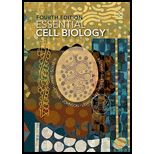
Concept explainers
A1.
To explain: The number of DNA fragments labelled in gray, green, or red, or outlined in yellow is produced if the PCR shown in Fig 10-15 runs additional two rounds of amplification.
Introduction: Polymerase chain reaction (PCR) is adevice used to amplify small fragments of DNA for various analyses. PCR is a cost-effective, dependable, and a simple way to repeatedly amplify, that is,to replicate a small fragment of DNA of interest. PCR is the most widely used molecular technique all over the world. PCR is done in simple steps:Denaturation of the DNA fragmentàAnnealing of the primersàElongation of the DNA fragment along the primer sideàDenaturationàCycle continues until the required DNA quantity is obtained. PCR is exclusively quantitative.
A1.
Explanation of Solution
The number of DNA produced in a generation is 2n, where ‘n’ is the number of generations. At the end of one additional round of amplification which is 25=32 DNA, there will be gray-2; green-4; red-4; and yellow outlined-22 fragments. At the end of one more additional round of amplification which is26=64 DNA, there will be gray-2; green-5; red-5; and yellow outlined-52 fragments. 2n-2 is the actual formula, where 2 is the parent DNA being conserved. Therefore, all generations has gray-2 in number.
A1.
To explain: The fragment that will predominate after several additional cycles.
Introduction: Polymerase chain reaction (PCR) is adevice used to amplify small fragments of DNA for various analyses. PCR is a cost-effective, dependable, and a simple way to repeatedly amplify, that is,to replicate a small fragment of DNA of interest. PCR is the most widely used molecular technique all over the world. PCR is done in simple steps:Denaturation of the DNA fragmentàAnnealing of the primersàElongation of the DNA fragment along the primer sideàDenaturationàCycle continues until the required DNA quantity is obtained. PCR is exclusively quantitative.
A1.
Explanation of Solution
The DNA fragments highlighted in yellow will increase exponentially and in the end dominates the others after several additional cycles. DNA sequence that spans the distance between the two primers + length of the primers = Total length of the DNA sequence that predominates.
B.
To calculate: The number of cycles of PCR amplification required to produce 100ng of DNA from a double-stranded DNA with 500
Introduction: Polymerase chain reaction (PCR) is adevice used to amplify small fragments of DNA for various analyses. PCR is a cost-effective, dependable, and a simple way to repeatedly amplify, that is,to replicate a small fragment of DNA of interest. PCR is the most widely used molecular technique all over the world. PCR is done in simple steps:Denaturation of the DNA fragmentàAnnealing of the primersàElongation of the DNA fragment along the primer sideàDenaturationàCycle continues until the required DNA quantity is obtained. PCR is exclusively quantitative.
B.
Explanation of Solution
Calculation:
To find the number of PCR cycles:
Thus, approximately 40 cycles of PCR are required to amplify 500 nucleotide pairs double-stranded DNA to obtain 100 ng of DNA. 100 ng of DNA is the minimum amount of DNA required for biochemical analysis. As PCR is automated, if the protocols are followed correctly, the entire procedure will take less than a day.
Want to see more full solutions like this?
Chapter 10 Solutions
Essential Cell Biology (Fourth Edition)
 Human Anatomy & Physiology (11th Edition)BiologyISBN:9780134580999Author:Elaine N. Marieb, Katja N. HoehnPublisher:PEARSON
Human Anatomy & Physiology (11th Edition)BiologyISBN:9780134580999Author:Elaine N. Marieb, Katja N. HoehnPublisher:PEARSON Biology 2eBiologyISBN:9781947172517Author:Matthew Douglas, Jung Choi, Mary Ann ClarkPublisher:OpenStax
Biology 2eBiologyISBN:9781947172517Author:Matthew Douglas, Jung Choi, Mary Ann ClarkPublisher:OpenStax Anatomy & PhysiologyBiologyISBN:9781259398629Author:McKinley, Michael P., O'loughlin, Valerie Dean, Bidle, Theresa StouterPublisher:Mcgraw Hill Education,
Anatomy & PhysiologyBiologyISBN:9781259398629Author:McKinley, Michael P., O'loughlin, Valerie Dean, Bidle, Theresa StouterPublisher:Mcgraw Hill Education, Molecular Biology of the Cell (Sixth Edition)BiologyISBN:9780815344322Author:Bruce Alberts, Alexander D. Johnson, Julian Lewis, David Morgan, Martin Raff, Keith Roberts, Peter WalterPublisher:W. W. Norton & Company
Molecular Biology of the Cell (Sixth Edition)BiologyISBN:9780815344322Author:Bruce Alberts, Alexander D. Johnson, Julian Lewis, David Morgan, Martin Raff, Keith Roberts, Peter WalterPublisher:W. W. Norton & Company Laboratory Manual For Human Anatomy & PhysiologyBiologyISBN:9781260159363Author:Martin, Terry R., Prentice-craver, CynthiaPublisher:McGraw-Hill Publishing Co.
Laboratory Manual For Human Anatomy & PhysiologyBiologyISBN:9781260159363Author:Martin, Terry R., Prentice-craver, CynthiaPublisher:McGraw-Hill Publishing Co. Inquiry Into Life (16th Edition)BiologyISBN:9781260231700Author:Sylvia S. Mader, Michael WindelspechtPublisher:McGraw Hill Education
Inquiry Into Life (16th Edition)BiologyISBN:9781260231700Author:Sylvia S. Mader, Michael WindelspechtPublisher:McGraw Hill Education





